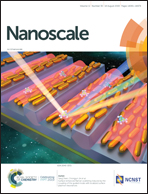Effect of interlayer spacing in layered perovskites on resistive switching memory†
Abstract
We report here the effect of interlayer spacing in 2-dimensional (2D) perovskites of [C6H5(CH2)nNH3]2PbI4 (anilinium (An) for n = 0, benzylammonium (BzA) for n = 1 and phenylethylammonium (PEA) for n = 2) on resistive switching properties. X-ray diffraction (XRD) reveals that the interlayer spacing of layered PbI2 is increased from 6.98 Å to 13.29 Å for (An)2PbI4, 14.20 Å for (BzA)2PbI4 and 15.92 Å for (PEA)2PbI4, which leads to a monolayer of organic cations with stacked benzene rings between inorganic PbI42− layers. All the samples in the device structure of Ag/PMMA (polymethyl methacrylate)/perovskite/Pt show bipolar switching behavior, where the SET voltage is near +0.2 V and the RESET voltage is less than −0.5 V. The ratio of LRS (low resistance state) to HRS (high resistance state), also called the ON/OFF ratio, is increased from 106 to 108 as interlayer spacing is increased due to the gradual increase in resistance in the HRS. Endurance is slightly improved from 1.3 × 102 for An to 2.2 × 102 for PEA, whereas substantial improvement in retention is observed from 2 × 103 to 5.5 × 103. This indicates that the enhanced 2D structure is beneficial to the kinetics of forming and rupturing the conducting filaments. The ohmic-like conduction mechanism in the LRS and the hopping mechanism in the HRS are observed for all three samples. This work finds that the resistive switching properties and conduction mechanism in the HRS depend on interlayer spacing in 2D perovskites.



 Please wait while we load your content...
Please wait while we load your content...